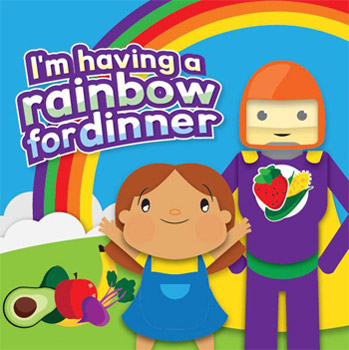New Health Weapon Converting Children To The 'Greener' Side

New Health Weapon Converting Children To The -Greener' Side
The simple act of reading aloud and sharing positive stories about food and nutrition can boost fruit and vegetable intake in young children, according to research.
Queensland-based dietitians found the number of fruit and vegetables eaten by children increased by an average of one serve per day after attending a story time session about good nutrition.
Aloysa Hourigan, an Accredited Practising Dietitian at Nutrition Australia Qld, is presenting her findings at the Dietitians Association of Australia (DAA) National Conference in Perth this week (13-16 May).
Ms Hourigan and her colleagues ran story time sessions in libraries and community organisations using a book they developed, I'm having a rainbow for dinner, which reached more than 300 children aged 13 months to six years.
'We all know how important it is that kids eat well and maintain a healthy weight, but the reality is it's not always easy. If you're like most parents, you've probably struggled at some point with the problem of how to get your kids to eat their veggies.
'Using story time with parents is a positive way to promote healthy eating habits, especially fruit and vegetable intake, and food and health literacy in young children," said Ms Hourigan.
Statistics show children aren't getting enough fruit and vegetablesi. Only one in two (49%) children aged 2-3 years eats the recommended 2.5 serves of veggies for healthy development of mind, body and brain. And for 4-8 year olds, this drops dramatically, with only nine per cent meeting the recommended amount.
Ms Hourigan said that after taking part in the story time sessions, children were more willing to try different vegetables and fruit, and parents gained confidence in offering children enough and different varieties of vegetables and fruit.
'For children, stories about nutrition need to be engaging and fun. Helping kids to become more familiar with and explore the taste and texture of different vegetables and fruit will increase the likelihood that they'll try more new foods.
'It also reinforces the message that eating enough vegetables and fruit can help children thrive and develop to their full potential," said Ms Hourigan.
Commenting on the research, DAA President Liz Kellett said being a good role model, making food fun, stocking nutritious foods at home, involving kids in cooking, and starting a family veggie garden are all positive ways parents can help young children develop healthy eating habits which continue into adulthood.
Ms Hourigan's study found the most popular fruit and vegetables with children were apples, bananas, watermelon, strawberries and corn.
The DAA National Conference is being held from 13-16 May 2015 at the Crown Perth Conference Centre. For more information and program details, visit: www.arinex.com.au/dietitians2015/ and follow us on Twitter: www.twitter.com/DAA_feed.
I'm Having A Rainbow For Dinner
I'm having a rainbow for dinner is based on two colourful characters: Kate (a young girl) and Josh (a superhero). It is an adventure story where Kate needs to try different coloured fruit and vegetables to help the rainbow get its colours back. This, in turn, helps Josh to once again become strong and run, jump and fly. The book includes recipes for families to cook at home.
Fruit And Vegetables: How Much Do Children Need?
A finding from Ms Hourigan's study was a lack of awareness among parents of the recommended number of serves of vegetables and fruit for children each day, which is:
2-3 year olds: 2.5 serves of vegetables, and 1 serve of fruit
4-8 year olds: 4.5 serves of vegetables, and 1.5 serves of fruit
Fruit and vegetables: What's a serve?
Vegetables:
½ cup of cooked vegetables (such as broccoli, spinach, carrots or pumpkin)
½ a medium potato
1 cup of salad vegetables
½ cup cooked dried or canned peas, beans or lentils
Fruit:
1 medium piece of fruit (apple, banana, orange, pear)
nutrition issues in the media. 2 small pieces fruit (apricots, kiwifruit, plums)
1 cup diced or canned fruit (no added sugar).
Rainbow Slice
Ingredients (serves 16)
1 cup reduced-fat tasty cheese
½ cup wholemeal self-raising flour
½ cup lean ham, thinly diced
3 spring onions, sliced finely
3 cups mixed grated vegetables (zucchini, carrot, pumpkin, sweet potato; can also add peas and corn)
Involving kids: Kids can assist with grating the vegetables or mixing the ingredients. Make sure they wash their hands first.
Method
Preheat oven to 180°C. Line a square or rectangular tin with baking paper or lightly spray with olive oil
Place all ingredients in a large bowl and mix gently until combined
Pour mixture into pan
Bake for 30-35 minutes or until set and golden brown
Allow to cool before slicing into rectangles. Serve immediately or keep refrigerated for up to three days.
May also be eaten cold.
Food safety tip: If using vegetables or fruit from the garden make sure they are washed thoroughly with clean water before eating to clean off any dirt or chemicals.
MORE



